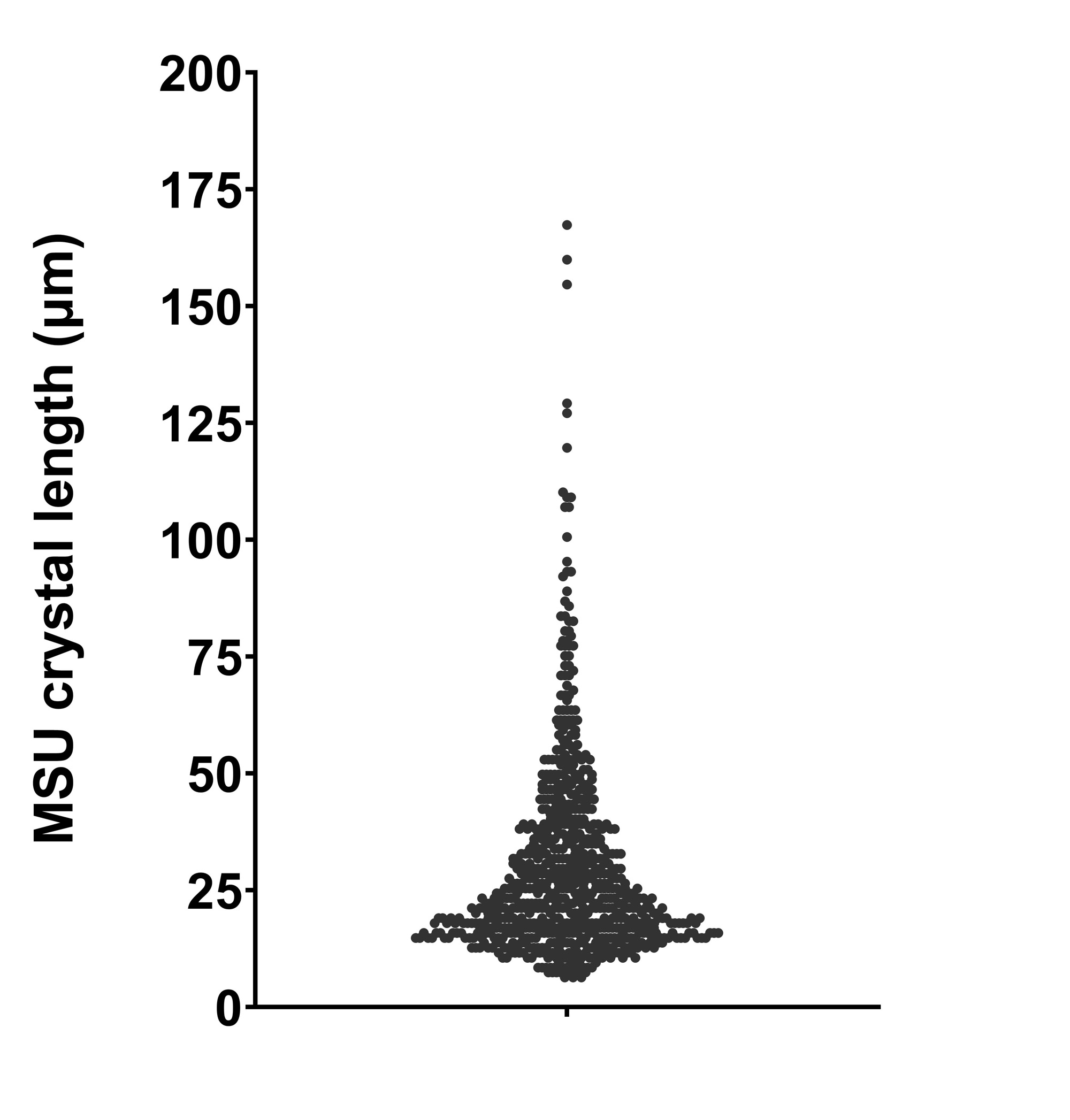Session Information
Date: Sunday, November 12, 2023
Title: Abstracts: Metabolic & Crystal Arthropathies – Basic & Clinical Science
Session Type: Abstract Session
Session Time: 4:00PM-5:30PM
Background/Purpose: We described bands of fibers having deposited orderly arrayed monosodium urate (MSU) crystals suggesting the need for protein templates to start crystallization [PMID 9709185]. However, tophi sections demonstrate the presence of longer crystals, highly arranged in a fan display, likely formed after other crystals [PMID 26369610]. Hence, a double mechanism of crystallization may exist in the joint. Here, we aimed to assess whether synovial fluid MSU crystals found in joints with organized sonographic deposits (likely, many crystals deriving from them) are longer than when deposits are absent or not visible.
Methods: We recruited patients with crystal-proven gout during a flare. Ultrasound of the target joint was performed to detect elementary gout lesions [OMERACT 2021]: double-contour (DC) sign, tophi, and aggregates. Two sonographic models were assessed: US-1 model, grade 2-3 of any deposit (DC sign, tophi, or aggregates), and US-2 model, limited to grade 2-3 DC sign or tophi. Later, synovial fluid was aspirated. The length of MSU crystals was measured by a blinded observer using a calibrated polarized light microscope. The distribution of MSU crystal length (in µm) and the presence of long crystals (defined according to percentiles 66, 75, or 90) were tested with each sonographic model using Mann-Whitney U’s test. Quantitative variables are shown as median (p25-75).
Results: We analyzed 742 crystals from 20 joints in 17 patients (three with an oligo-polyarticular flare), median aged 62.5 years (55-73), and 30% with subcutaneous tophi. The 2-year median serum urate was 7.5mg/dL (7.1-8.2), with current urate-lowering therapy in 35% of patients. The median length of MSU crystals was 21.2µm (95%CI 17.7-26.5), where crystals mostly gathered [Figure 1]. Applying the US-1 model (fulfilled by 13 joints, 65%), no difference in crystal lengths was noted (21.2µm in those with deposits vs. 21.2µm in those without deposits; p=0.588) [Figure 2, top], with a similar distribution of long crystals (P66, P75 or P90) [Figure 2, middle and bottom]. However, those with deposits according to US-2 model (n=9, 45%) showed a numerically greater crystal length (22.8µm vs. 18.5µm; p=0.112) [Figure 2, top] and more presence of long crystals [Figure 2, middle and bottom] compared to patients without deposits. Crystal lengths and the presence of long crystals showed no association with gout characteristics or serum urate levels.
Conclusion: Our synovial fluid analysis from different individuals with gout suggests two different mechanisms of MSU crystallization, one of reduced length shared by most crystals and the other with longer crystals better identified by the presence of sonographic deposits (but not aggregates), which resembles what is seen in tophi pathological sections. This exploratory finding adds evidence to the hypothesis that a secondary formation using as templates previously formed crystals occurs in the process of MSU crystallization.
To cite this abstract in AMA style:
Sansano E, López-González M, Rodríguez-Alvear C, Calabuig-Sais I, Martínez-Sanchís A, Pascual E, Andrés M. Length of Synovial Fluid Monosodium Urate Crystals According to Sonographic Articular Deposits: Advancing in the Crystallization Process [abstract]. Arthritis Rheumatol. 2023; 75 (suppl 9). https://acrabstracts.org/abstract/length-of-synovial-fluid-monosodium-urate-crystals-according-to-sonographic-articular-deposits-advancing-in-the-crystallization-process/. Accessed .« Back to ACR Convergence 2023
ACR Meeting Abstracts - https://acrabstracts.org/abstract/length-of-synovial-fluid-monosodium-urate-crystals-according-to-sonographic-articular-deposits-advancing-in-the-crystallization-process/


